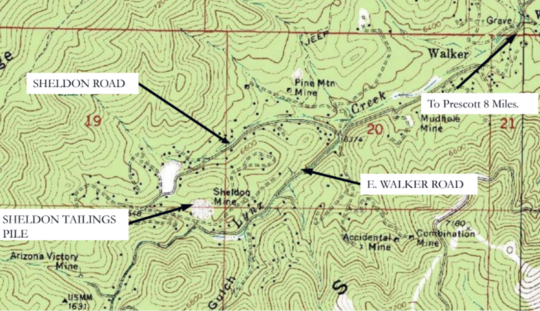WALKER, AZ — Residents in a northern Arizona community are being told an "orange sludge" that was discovered earlier this month is not harmful.
The Arizona Department of Environmental Quality (ADEQ) previously issued the advisory for people in Walker, southeast of Prescott.
LIQUID ORANGE: state environment officials in Arizona are warning of this orange liquid that is now covering land near an old mine.
— Nicole Grigg (@NicoleSGrigg) April 1, 2023
This is in Yavapai County in the area of Walker where I’m told over 200 people live.
At this time, ADEQ officials don’t know if it is toxic /1 pic.twitter.com/hKPrKGkwpG
The area impacted is near Eagle Road and New Strike Lane, surrounding the former Sheldon Mine.

ADEQ was first alerted about the substance near Sheldon Road and Midnight Snap Lane on Thursday after a resident spotted it.
As a precaution, everyone was told to avoid contact with the orange liquid or soil.
Due to recent rain, snow, and precipitation in the area, this orange liquid may be surfacing in other nearby areas, ADEQ said.
According to ADOT, test results indicate the orange coloration is due to naturally-occurring iron. As iron is exposed to air, it forms iron oxide, which is orange or red in color. Based on the heavily mineralized geology in this former mining district, ADEQ tested the samples (surface water and soil) for metals (barium, cadmium, chromium, lead, mercury, selenium, silver, iron), arsenic, cyanide, and pH. Test results confirm that surface water and soil in the area do not pose an immediate threat to public health and that no remediation activities are warranted.
ADEQ told ABC15 that they conducted three soil and four water samples, upstream and downstream of where the most significant amount of orange liquid and soils were located.
“The samples collected are being tested for metals (arsenic, barium, cadmium, chromium, lead, mercury, selenium, and silver), iron, cyanide, and pH,” a spokesperson for ADEQ said by email.
The EPA has been monitoring the Sheldon Mine as part of a large group of mine sites throughout the Prescott National Forest.
A spokesperson for the EPA said in an email that acid mine drainage can be present in the area, “The name can be misleading as acid mine drainage can result from any land disturbance where the right geological and rain conditions exist. Acid mine drainage is common throughout the Bradshaw Mountains.
Treating acid mine drainage is particularly difficult at this Site because the rock pile (or spring) is often dry – when the ground or pile becomes saturated, acid mine drainage will occur. Otherwise, stopping acid mine drainage requires the iron-bearing rock to be cut off from microbial activity which is very difficult to do in a large rock pile.”
They add that past testing at this site has not found concentrations greater than other streams in the area, so treatment of the acid mine drainage has not been a priority around Sheldon Mine, “EPA would be open to partnering with local and state officials at their request,” they added.
ADEQ said they requested fast turnaround times for the results, and we will share them when they are available.
Researchers with the University of Arizona are working on compiling a comprehensive list of abandoned mines in Arizona.
Mark Barton with the Lowell Institute for Mineral Resources at the University of Arizona said there are tens of thousands old holes in the ground in Arizona that were excavated for some purpose, but the number of mines that produced material is thousands.
Dr. Julie Neilson is a research professor at U Arizona and is working on compiling a comprehensive list of old mines in the state, “one of the goals reasons that ADEQ wants this database, is they want to be able to prioritize what are the sites? And what have where do we need to start, you know, where are the most critical ones that we work on?,” she said.
Dr. Neilson said different local and federal agencies have their own lists of where abandoned mines are, but the different systems don’t connect well.
“None of them are complete, and none of them can talk to each other,” she added.






